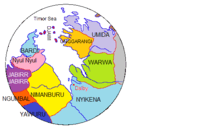Jawi people
The Jawi people, also spelt Djaui, Djawi, and other alternative spellings, are an Indigenous Australian people of the Kimberley coast of Western Australia, who speak the Jawi dialect. They are sometimes grouped with the Bardi people and referred to as "Bardi Jawi", as the languages and culture are similar.
Language
The Jawi dialect belongs to the western branch of the non-Pama-Nyungan, Nyulnyulan family. It is close to Bardi.
Social and economic organisation
The Jawi were industrious seafaring traders. The Unggarrangu furnished them with mandjilal wood for their catamarans, and the Jawi in turn supplied the Bardi with this buoyant mangrove timber for the Bardi people's log rafts.[1] They in turn bartered shells in return for wooden spears from the inland Warwa and Njikena tribes.[2]
Country

Including outlying reefs of the archipelago, the Jawi (Iwany-oon, meaning "Sunday Islanders")[3] controlled about 50 square miles (130 km2) of territory, with their centres at Tohau-i (probably = Jawi) and Sunday Island (Ewenu) (= Iwany) in the King Sound. To their north lay West Roe. The western limit was Jackson Island, also called Jayirri or Tyra Island.
History of contact
A one-time pearler, Sydney Hadley, a reformed alcoholic who had spent long stints in gaol, set up a mission on Sunday Island in 1899.[4][5]
Towards the end of WW2, H. H. J. Coate, who was engaged in a study of Bardi, took over the running of the mission.[6]
Alternative names
- Chowie
- Djaoi
- Djau
- Djawi
- Ewanji, Ewenyoon, I:wanja
- Ewenu
- Tohau-i. (an insular toponym referring to the main island of the Buccaneer Archipelago)
- Tohawi
Source: Tindale 1974, p. 241
Notes
Citations
- Tindale 1974, pp. 57–58.
- Tindale 1974, p. 84.
- Bowern 2008, p. 283.
- McGregor 2013, p. 11.
- Hunter 1993, p. 44.
- McGregor 2013, p. 16.
Sources
- "AIATSIS map of Indigenous Australia". AIATSIS.
- Bird, W. H. (1910). "Some Remarks on the Grammatical Construction of the Chowie-Language, as Spoken by the Buccaneer Islanders, North-Western Australia". Anthropos. 5 (5): 454–456. JSTOR 40443562.CS1 maint: ref=harv (link)
- Bird, W. H. (1911). "Ethnographical Notes about the Buccaneer Islanders, North Western Australia". Anthropos. 6 (1): 174–178. JSTOR 40444080.CS1 maint: ref=harv (link)
- Bird, W. H. (January–April 1915). "A Short Vocabulary of the Chowie-Language of the Buccaneer Islanders (Sunday Islanders),North Western Australia". Anthropos. 10/11 (1/2): 180–186. JSTOR 40442801.CS1 maint: ref=harv (link)
- Bowern, Claire (2008). "History of research on Bardi and Jawi". In McGregor, William (ed.). Encountering Aboriginal languages: studies in the history of Australian linguistics. Pacific Linguistics Research School of Pacific and Asian Studies. pp. 59–84. ISBN 978-0-858-83582-5.CS1 maint: ref=harv (link)
- Coate, H. H. J. (December 1966). "The Rai and the Third Eye North-West Australian Beliefs". Oceania. 37 (2): 93–123. JSTOR 40329629.CS1 maint: ref=harv (link)
- Elkin, A. P. (March 1932). "Social Organization in the Kimberley Division, North-Western Australia". Oceania. 2 (3): 296–333. JSTOR 27976150.CS1 maint: ref=harv (link)
- Elkin, A. P. (1935). "Initiation in the Bard tribe". Journal of the Proceedings of the Royal Society of New South Wales. 69: 190–208.CS1 maint: ref=harv (link)
- Hunter, Ernest (1993). Aboriginal Health and History: Power and Prejudice in Remote Australia. Cambridge University Press. ISBN 978-0-521-44760-7.CS1 maint: ref=harv (link)
- McGregor, William B. (2013). The Languages of the Kimberley, Western Australia. Routledge. ISBN 978-1-134-39602-3.CS1 maint: ref=harv (link)
- Petri, Helmut (October 1939). "Mythische Heroen und Urzeitlegende im nördlichen Dampierland, Nordwest-Australien". Paideuma: Mitteilungen zur Kulturkunde. Frobenius. 1 (5): 217–240. JSTOR 40341058.CS1 maint: ref=harv (link)
- "Tindale Tribal Boundaries" (PDF). Department of Aboriginal Affairs, Western Australia. September 2016.
- Tindale, Norman Barnett (1974). "Djaui (WA)". Aboriginal Tribes of Australia: Their Terrain, Environmental Controls, Distribution, Limits, and Proper Names. Australian National University. ISBN 978-0-708-10741-6.CS1 maint: ref=harv (link)
- Worms, E. A. (December 1950). "Djamar, the Creator. A Myth of the Bād (West Kimberley, Australia)". Anthropos. 45 (4/6.): 641–658. JSTOR 40449333.CS1 maint: ref=harv (link)